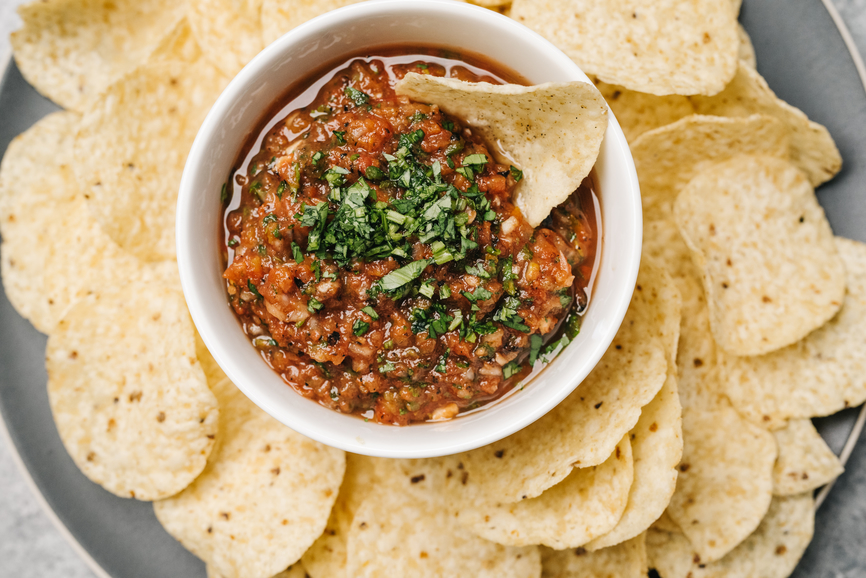Where there’s a bowl of freshly-fried crispy tortilla chips, there’s likely a bowl of zesty tomato salsa that follows suit. And although there’s nothing wrong with a store-bought tub of hot salsa roja, a homemade batch is always better. To make our lives even easier, we found an effortless way to prepare the best salsa you’ve ever had using your air fryer. So, give your overly ripe produce a second chance and turn your bruised tomatoes and jalapeños into the roasted salsa of your dreams in mere minutes with this simple air fryer hack.
How to make salsa using an air fryer
It’s true: There isn’t much an air fryer can’t do, including making a mean DIY salsa recipe. In a recent TikTok video by @melissas_healthykitchen, Melissa demonstrates how to make a five-ingredient air fryer salsa recipe in less than 30 minutes. To make it, she starts by adding five Roma tomatoes, half of a medium yellow onion roughly chopped, one jalapeño deseeded and sliced down the center lengthwise, and four garlic cloves with the skin on into the basket of the air fryer.
@melissas_healthykitchen Air fryer salsa??#airfryersalsa #redsalsa #salsarecipe #easysalsa #easysalsarecipes #roastedsalsa ♬ original sound – Melissas_healthykitchen
Then, Melissa drizzles the ingredients with avocado oil and cooks it at 400°F for 22-24 minutes. About halfway through, she recommends giving it a good shake to prevent unwanted sticking and ensure the produce is cooked thoroughly. Once it’s done, she transfers the contents to a food processor. (Don’t forget to squeeze the roasted garlic out of the peels before blending.) Then, Melissa adds a half cup of fresh cilantro and seasons the mixture with salt to taste. Lastly, she pulses the ingredients until she reaches the desired consistency.
For best results, Melissa recommends allowing the salsa to rest for about an hour before digging in to allow the flavors to meld together. Once ready, she serves it with a heaping bowl of tortilla chips (obvi) and digs right in. This simple, big-batch recipe is also leftover-friendly: It can be stored in the fridge in an airtight container for up to three to four days.
What are the health benefits of salsa?
Variations of salsa have been around for centuries, and its origins date back to the time of the Aztecs, Incas, and Mayans. In Mexico, there are tons of salsa recipes these days. Among the most popular are salsa verde, made from green tomatillos, often served with dishes like chilaquiles, or salsa macha, made from dried peppers, nuts, and oil, ideal for drizzling over soups and tortillas, to name a few. But aside from its delicious flavor, these delicious sauces also boast a bevy of health benefits.
Let’s deconstruct Melissa’s recipe and hone in on each ingredient’s benefits. First things first: Tomatoes, an explosion of antioxidants. Primarily found in the peels of this fruit, tomatoes are packed with lycopene, ascorbic acid (aka vitamin C), and phenolic contents, all of which give them their potent anti-inflammatory properties.
Meanwhile, onions and garlic can enhance the bioavailability of zinc and iron in foods, which is why you might find them used as the foundation for just about every savory recipe. (Of course, their delicious flavor helps, too.) Studies have shown that when alliums (like onions and garlic) are paired with other foods like grains and pulses, zinc and iron levels are more readily available for the body. Keep in mind that zinc is vital for immune function, and iron helps regulate hemoglobin levels in the blood.
Plus, who can forget the jalapeños? They’re rich in vitamins A and C and potassium, and they’re loaded with capsaicin, an active compound found in peppers that studies have linked to boosting longevity. Research shows capsaicin can help regulate metabolism, lower cholesterol, and support a healthy microbiome.
So, who’s bringing the chips? And, more importantly, are we getting scoops or triangles?
How to make an easy chickpea goddess sauce:
